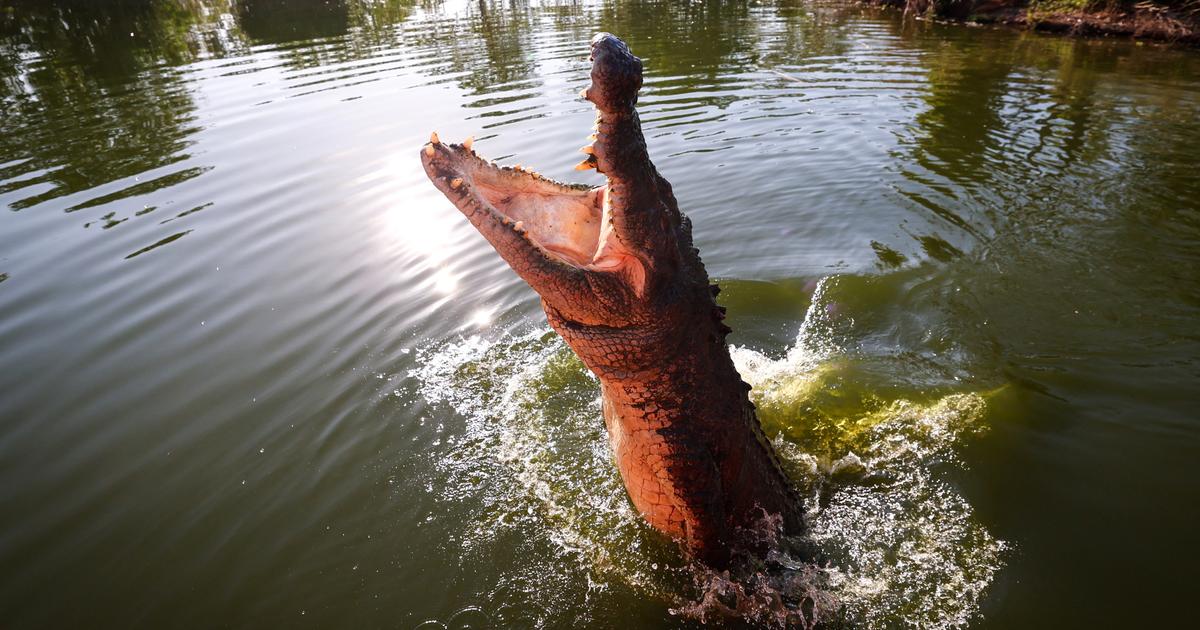After coming close to extinction, saltwater crocodiles now swim by the hundreds in a river near Darwin, in northern Australia.
So much so that humans have had to learn to live alongside these
“extremely dangerous”
predators .
“You can't coax crocodiles
,” warns conservation program manager Grahame Webb in his tropical garden.
To discover
Travel to Australia: tailor-made tours, hotels and stays from our partners
Before the Australian government began protecting saltwater crocodiles in the 1970s, 98% of the wild population had disappeared from the Northern Territory, due to demand for leather and culling.
Today, authorities estimate that there are more than 100,000 crocodiles, measuring up to six meters long and weighing up to a ton, that hunt along the coasts, rivers and wetlands of the extreme north of the mainland country.
“It was a real success
,” emphasizes Grahame Webb.
But protecting the animals was only the first step.
“To protect from predators, you have to replenish their population.
If you succeed, they start eating people again, and everyone wants to get rid of them
.
For Charlie Manolis, crocodile expert from the International Union for Conservation of Nature (IUCN), in the 1980s people had to become aware of the value of these animals in order to tolerate them as neighbors.
Eggs collected for breeding farms
A safety campaign, with signs along rivers, and transfers of predators out of densely populated areas have contributed to a more peaceful coexistence with residents.
A permitted harvest of wild eggs has been implemented in the Northern Territory.
Landowners, many of them Aboriginal, are paid for wild eggs collected on their land for breeding farms, which supply the leather industry.
Some 70,000 eggs and 1,400 crocodiles can be collected from the wild each year.
“A lot of people work thanks to crocodiles
,” particularly in breeding and tourism, says Mr. Webb.
It is estimated that crocodile farming brings in more than 100 million Australian dollars (61 million euros) per year for the territory, which is Australia's largest producer of skins.
The leather obtained is very popular with luxury brands like Hermès or Louis Vuitton.
This strategy helped save the species from mass slaughter, underlines Charlie Manolis.
“I was in mining, then I was a mother, and now I'm a crocodile keeper,”
says Jess Grills, 32, smiling as she drives a boat on a lazy river at Crocodylus Park, a tourist attraction near Darwin.
A fear rooted for a million years
A crocodile in a lagoon in Crocodylus Park, located on the outskirts of the city of Darwin, Australia.
DAVID GRAY / AFP
The park, founded by Grahame Webb, is a
"haven"
for
"problem crocodiles"
, animals removed from the wild because they represent a danger to the population or because they tend to attack livestock.
“You can't train a crocodile, but you can move it to a place where it won't cause a problem,”
she explains, tying a piece of meat to a long pole.
She hits the water with this bait and swings it above the surface.
The green snout of Prince, a crocodile known as a
"livestock eater"
, slowly surfaces, followed by his glowing eyes.
Suddenly, the beast jumps vertically, its jaws open, before closing them on the flesh and falling back into the water.
This show sends a clear message to visitors: be wary of the places where these animals hunt and live.
“You always have to assume that there is a crocodile in the water, no matter what
,” notes Jess Grills.
As the crocodile population grows and larger individuals become more common, attacks, although rare, are likely to increase, warns Charlie Manolis.
Overcoming a fear that has been ingrained for
“a million years”
while continuing the program to protect the species is a vast challenge, he emphasizes.
“Let's be real, the WWF (World Wide Fund for Nature) does not have a photo of a crocodile”
on its logo.
“There is a panda”
.
For Jess Grills, the opportunity to admire these predators up close helps promote the protection of the species.
“If you respect them and their territory, I don’t think they’re that terrifying
. ”
In video -
A giant crocodile jumps into a swimming pool in Florida!

